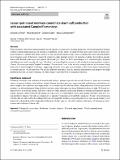Files in this item
Lesser spot-nosed monkeys coordinate alarm call production with associated Campbell’s monkeys
Item metadata
| dc.contributor.author | Le Floch, Auriane | |
| dc.contributor.author | Bouchard, Alice | |
| dc.contributor.author | Gallot, Quentin | |
| dc.contributor.author | Zuberbühler, Klaus | |
| dc.date.accessioned | 2021-07-28T11:30:18Z | |
| dc.date.available | 2021-07-28T11:30:18Z | |
| dc.date.issued | 2021-07-26 | |
| dc.identifier | 275226961 | |
| dc.identifier | 2937528f-9f97-42cd-bf7d-45c1884adfbd | |
| dc.identifier | 85111252677 | |
| dc.identifier | 000677835800001 | |
| dc.identifier.citation | Le Floch , A , Bouchard , A , Gallot , Q & Zuberbühler , K 2021 , ' Lesser spot-nosed monkeys coordinate alarm call production with associated Campbell’s monkeys ' , Behavioral Ecology and Sociobiology , vol. 75 , no. 8 , 112 . https://doi.org/10.1007/s00265-021-03053-w | en |
| dc.identifier.issn | 1432-0762 | |
| dc.identifier.other | RIS: urn:D11105088B66E0C12633A04BC4680418 | |
| dc.identifier.other | RIS: Le Floch2021 | |
| dc.identifier.other | ORCID: /0000-0001-8378-088X/work/97884603 | |
| dc.identifier.uri | https://hdl.handle.net/10023/23661 | |
| dc.description | Open Access funding provided by Université de Neuchâtel. The Taï Monkey Project has been partially funded by grants from the Swiss National Science Foundation (#310030_185324; #31003A_166458). ALF has been supported by a Willy Müller Award from the Centre Suisse de Recherches Scientifiques en Côte d’Ivoire and the University of Neuchâtel. AB and QG have been funded by the University of Neuchâtel and the Swiss National Science Foundation (#31003A_166458). KZ is supported by ‘NCCR Evolving Language’, Swiss National Science Foundation Agreement #51NF40_180888. | en |
| dc.description.abstract | Forest monkeys often form semi-permanent mixed-species associations to increase group-size related anti-predator benefits without corresponding increases in resource competition. In this study, we analysed the alarm call system of lesser spot-nosed monkeys, a primate that spends most of its time in mixed-species groups while occupying the lowest and presumably most dangerous part of the forest canopy. In contrast to other primate species, we found no evidence for predator-specific alarm calls. Instead, males gave one general alarm call type (‘kroo’) to three main dangers (i.e., crowned eagles, leopards and falling trees) and a second call type (‘tcha-kow’) as a coordinated response to calls produced in non-predatory contexts (‘boom’) by associated male Campbell’s monkeys. Production of ‘kroo’ calls was also strongly affected by the alarm calling behaviour of male Campbell’s monkeys, suggesting that male lesser spot-nosed monkeys adjust their alarm call production to another species’ vocal behaviour. We discuss different hypotheses for this unusual phenomenon and propose that high predation pressure can lead to reliance on other species vocal behaviour to minimise predation. | |
| dc.format.extent | 14 | |
| dc.format.extent | 949243 | |
| dc.language.iso | eng | |
| dc.relation.ispartof | Behavioral Ecology and Sociobiology | en |
| dc.subject | Polyspecific association | en |
| dc.subject | Predation | en |
| dc.subject | Acoustic analyses | en |
| dc.subject | Playback experiments | en |
| dc.subject | Vocal communication | en |
| dc.subject | Cercopithecus petaurista | en |
| dc.subject | QL Zoology | en |
| dc.subject | DAS | en |
| dc.subject.lcc | QL | en |
| dc.title | Lesser spot-nosed monkeys coordinate alarm call production with associated Campbell’s monkeys | en |
| dc.type | Journal article | en |
| dc.contributor.institution | University of St Andrews. School of Psychology and Neuroscience | en |
| dc.contributor.institution | University of St Andrews. Institute of Behavioural and Neural Sciences | en |
| dc.contributor.institution | University of St Andrews. Centre for Social Learning & Cognitive Evolution | en |
| dc.identifier.doi | https://doi.org/10.1007/s00265-021-03053-w | |
| dc.description.status | Peer reviewed | en |
| dc.identifier.url | https://link.springer.com/article/10.1007%2Fs00265-021-03053-w#Sec18 | en |
This item appears in the following Collection(s)
Items in the St Andrews Research Repository are protected by copyright, with all rights reserved, unless otherwise indicated.

